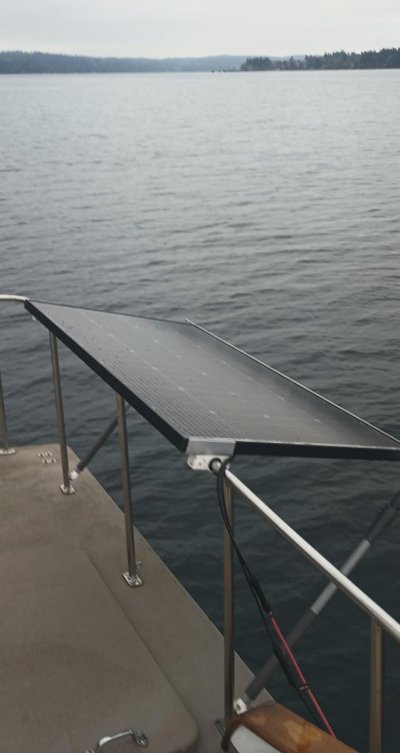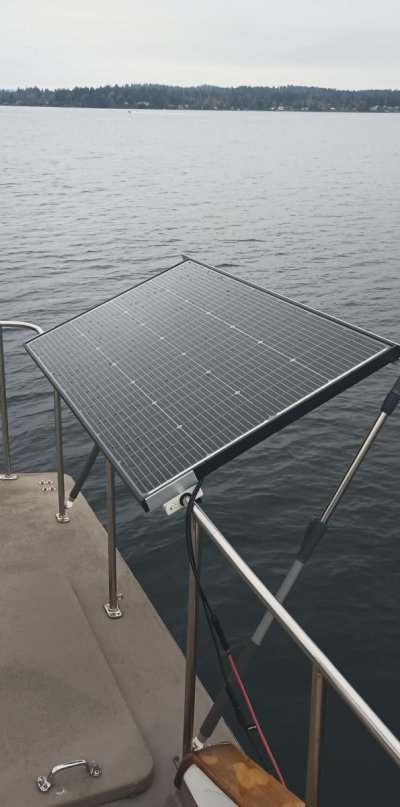Marco Flamingo
Guru
- Joined
- Jan 7, 2020
- Messages
- 1,137
- Location
- United States
- Vessel Name
- CHiTON
- Vessel Make
- Tung Hwa Clipper 30
I had not even heard of these until a few weeks ago. I was looking to add a solar panel and came across the concept. Basically, a solar photo cell that collects on both sides isn't that difficult to make, but it has had little practical application (the Soviets first used them in outer space). Unless the background is white (like snow), the shade underneath a solar panel isn't enough to add much electrical power from the backside. That is why bifacial solar panels are mostly used suspended such that sunlight gets underneath them. The other issue is that the mounting system can't block light to the backside.
There seemed to be a couple of benefits for bifacial on a boat. First, there is an odd tariff on Chinese solar panels right now that (for some unknown reason) does not apply to bifacial panels. The tariff is such that the price of a 200W bifacial solar panel is the same as a regular panel even though they are more costly to produce. The main structural difference is that the back of a bifacial has another sheet of glass instead of the "normal" opaque white plastic. Bifacial are heavier, sturdier and, right now, the same price.
The panels are rated by their "right side" production. A panel rated at 200W should produce 200W under perfect conditions even with the back covered. The "back side" watt production isn't included. Various manufacturers claim a 10 to 30% increase from bifacial. The highest gain I saw in a laboratory test was 50% by maximizing the ambient reflected light behind the panel (called albedo).
So, same price and the possibility of a 30% kicker, I went with bifacial. It actually fit my application as I was intending to hang the panel to the outside of the boat from the flying bridge railing. Plenty of opportunity for light to bounce up from the water to the underside of the panel. You can get the idea from the pictures below.
As a bonus, some of the detailed measurements of bifacial panels have found that they have an additional advantage in partial shade conditions. Shading from something as little as the shadow produced by a mast stay can drastically effect output. Bifacial panels, when benefiting from albedo, suffer much less. Instead of a little shadow producing a 75% drop in wattage, it might only produce a 40% drop. Sounded interesting.
I'm in covered moorage, so no testing without cruising. I'm also near Seattle, so no sun until next May. Actually, we went out this rainy weekend and did monitor the panel through my new bluetooth MPPT controller. Sunday morning at 9 a.m., with complete cloud cover and rain, it was producing .5 amps. I tipped it towards where I thought the sun might be and got .7 amps. Later at noon, I guessed where the sun probably was and got 3.2 amps. So only a trickle charge on dark, cloudy, rainy days. Can't wait for some actual sunshine. We say that a lot here.
There seemed to be a couple of benefits for bifacial on a boat. First, there is an odd tariff on Chinese solar panels right now that (for some unknown reason) does not apply to bifacial panels. The tariff is such that the price of a 200W bifacial solar panel is the same as a regular panel even though they are more costly to produce. The main structural difference is that the back of a bifacial has another sheet of glass instead of the "normal" opaque white plastic. Bifacial are heavier, sturdier and, right now, the same price.
The panels are rated by their "right side" production. A panel rated at 200W should produce 200W under perfect conditions even with the back covered. The "back side" watt production isn't included. Various manufacturers claim a 10 to 30% increase from bifacial. The highest gain I saw in a laboratory test was 50% by maximizing the ambient reflected light behind the panel (called albedo).
So, same price and the possibility of a 30% kicker, I went with bifacial. It actually fit my application as I was intending to hang the panel to the outside of the boat from the flying bridge railing. Plenty of opportunity for light to bounce up from the water to the underside of the panel. You can get the idea from the pictures below.
As a bonus, some of the detailed measurements of bifacial panels have found that they have an additional advantage in partial shade conditions. Shading from something as little as the shadow produced by a mast stay can drastically effect output. Bifacial panels, when benefiting from albedo, suffer much less. Instead of a little shadow producing a 75% drop in wattage, it might only produce a 40% drop. Sounded interesting.
I'm in covered moorage, so no testing without cruising. I'm also near Seattle, so no sun until next May. Actually, we went out this rainy weekend and did monitor the panel through my new bluetooth MPPT controller. Sunday morning at 9 a.m., with complete cloud cover and rain, it was producing .5 amps. I tipped it towards where I thought the sun might be and got .7 amps. Later at noon, I guessed where the sun probably was and got 3.2 amps. So only a trickle charge on dark, cloudy, rainy days. Can't wait for some actual sunshine. We say that a lot here.
Attachments
Last edited:


